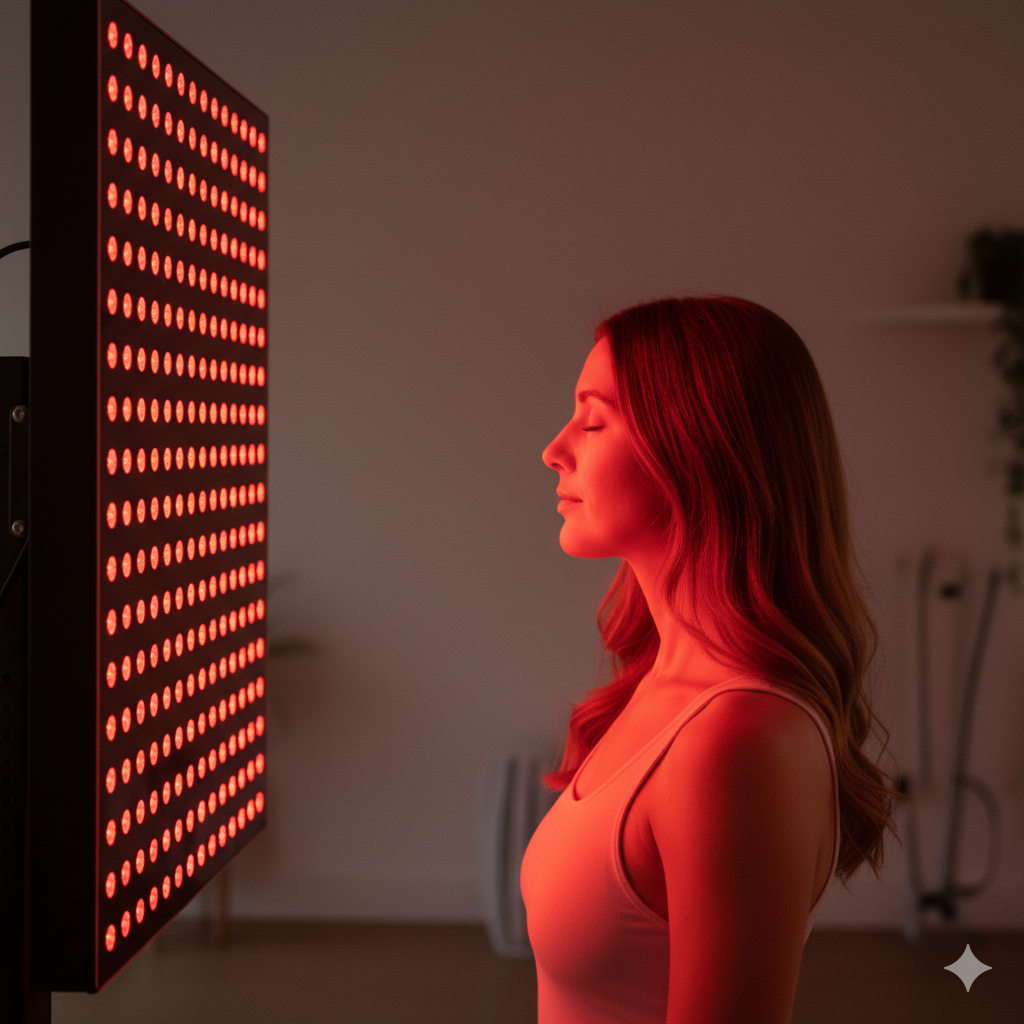Quick summary:
Red light therapy (670nm) can help cells in and around the eyes work better—mainly by nudging mitochondria (your cells’ tiny power plants) to make energy (ATP). But just like coffee, a small cup can help, too much can jitter or crash you. With light, this “sweet spot” idea is called a biphasic response: low doses help, high doses can backfire. This article explains what “too much” looks like for the eyes—and how to stay in the safe, useful zone.
The big idea: how too much red light can reduce energy (ATP)
Mitochondria make ATP using a set of proteins, including a key one called cytochrome-c-oxidase (CCO). Red light can gently boost CCO—up to a point. Beyond that:
-
CCO gets “saturated”
Think of a sponge: once it’s soaked, more water just drips off. Extra light no longer helps CCO and can actually slow the system. -
Extra “signal” molecules turn into stress
Tiny amounts of reactive oxygen species (ROS) are normal “go” signals for cells. Too much light can push ROS too high → oxidative stress that slows ATP-making enzymes. -
Battery charge gets wobbly
Mitochondria rely on an electrical gradient (like a battery). Too much light can flatten that gradient, making ATP production less efficient. -
Nitric oxide (NO) balance gets thrown off
Right-sized light helps clear NO from CCO so electrons flow. Too much can dysregulate this balance and bog down the energy chain.
Bottom line: High dose red light from red light panels and certain masks may be in excess of what your eyes need. In essence, more light ≠ more benefit. Cells want a just-right amount.
What this means for your eyes
1) Eyelids & skin around the eyes (including meibomian glands)
-
What can go wrong if you overdo it: warmth, redness, puffy lids, flare-ups of ocular rosacea, stinging or burning, and “fatigue” in oil glands that can worsen dryness.
-
Why: extra surface-level ROS and mitochondrial “battery wobble” in gland cells.
2) Tear film, conjunctiva, and cornea (the surface)
-
What you might feel: more dryness, gritty/foreign-body sensation, light sensitivity, or temporary blur after a session.
-
Why: surface cells get irritated when ROS rises and energy production dips.
3) Lens (the eye’s clear focusing structure)
-
Short term: usually no symptoms.
-
Long term risk (theoretical at high/chronically excessive doses): extra oxidative burden could nudge lens proteins in the wrong direction.
-
Takeaway: don’t “chase heat/time” to force results.
4) Retina & RPE (“mitochondria in the back”)
-
Important note: If you use red light with eyes open (not advised for therapy), the eye’s optics focus red onto the retina.
-
Too much can cause: afterimages, visual “noise,” reduced contrast, eye ache, or slower dark adaptation for minutes to hours.
-
Why: the same ATP-inhibiting effects—CCO saturation, ROS overshoot, and a flattened mitochondrial gradient—now in energy-hungry retinal cells.
Where Arunalight fits (dose, timing, safety guardrails)
Arunalight is purpose-built for the ocular region with strictly red light at 670 nm and a conservative, low dose: >
-
Irradiance: 45 mW/cm²
-
Time: 3 minutes (auto shut-off)
-
Dose per session: 8.1 J/cm² (45 mW/cm² × 180 s)
-
Cadence: every other day
This combo is designed to sit inside the beneficial window—enough to engage mitochondria without pushing into the inhibitory zone. The automatic shut-down and every-other-day schedule do a lot of the “dose discipline” for you.
Why not substitute a generic high-dose panel or mask?
- Wrong intensity: Many panels run far higher irradiance and invite overexposure within minutes—especially dangerous if users keep eyes open.
- No ocular-specific dosing: Panels are made for backs/knees, not delicate ocular surfaces; “copy-pasting” body doses to eyes often overshoots.
- No built-in guardrails: Without auto shut-off and an every-other-day protocol, it’s easy to “dose stack” and cross the line from help → irritation.
- Optical geometry matters: The eye’s optics focus red light onto the retina if the eyes are open. Arunalight is meant for eyes-closed, periocular use at a planned dose.
- Panels emit light across a broad field and from a distance, but a significant portion of red light—up to 80%, according to reports—is lost due to reflection and scattering. For precise ocular dosing, a close-proximity, eyes-closed delivery method offers far greater reliability and consistency.
If the goal is eye comfort and mitochondrial support around the eyes, don’t try to hack it with a bright body panel or mask. Use a purpose-built, low-dose, eyes-closed device like Arunalight that keeps you in the sweet spot.

